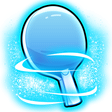Rubber thickness
Equipment
Ardak . Asked 3 years ago
Hi, coach!
I noticed that when I was playing with (two different) 2 mm thick rubbers on FH side, almost all my topspins was landing to the table. And with maximum thick rubbers, I have some troubles. When I do FH topspins, several FH topspins in a set flies off the table. Is it coincidence? With thinner rubbers is it easier to do FH topspins? Or depends on many other things: blade, opponents' strokes, position during the stroke (technique), etc ?
 Alois Rosario Answered 3 years ago
Alois Rosario Answered 3 years ago
Hi Ardak,
The increase in the thickness of the rubber will make a difference with the speed of the racket. The thicker the sponge the more speed and spin you will generate.
Recommended Video
Thoughts on this question
Become a free member to post a comment about this question.
Ardak . Posted 3 years ago
Thank you, coach!
"The thicker the sponge the more speed"
Is this "more speed" reasons more straight trajectory compared to thin rubber?
Yes the hall will travel further and bounce forward if your racket with the more speed. If you brush the ball on contact you can get more spin which will bring the ball down.
D K Posted 3 years ago
Though be careful about several things:
1)Although it is true that thicker sponge means more speed and spin,it is ALSO true that there are more variables which affect the trajectory,as you mentioned-opponent's strokes,technique,some players are even sensitive between different balls and tables.
2)I have read somewhere that it is a reverse true in case of antitopspin rubbers: thicker anti sponges provide more cushion,more absorption,meaning that thick sponge antitopspin should be slower than thin sponge one